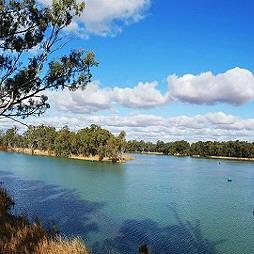Posted 13 April 2012

Part of the Murray-Darling river system at Wentworth, NSW (Credit: Wikimedia Commons)
The volume of water needed to secure the long-term sustainability of the Murray-Darling river system cannot be identified clearly due to a lack of transparency in the proposed Murray-Darling Basin Plan, more than 60 Australian scientists say in a special joint statement.
The proposed plan's aim to return 2,750 gigalitres (GL) a year to the environment would be of enormous value but falls short of meeting all the targets identified as needing to be met to protect key natural assets and ecosystem functions, the statement says.
Those targets need to be better defined and would be met increasingly by returning greater volumes of water, it notes, yet the proposed plan gives too little detail on what those volumes might be, what they might achieve and why they cannot be achieved:
"Indeed, it is not clear why the proposed Basin Plan should not meet all targets, in keeping with the Water Act 2007."
The proposed plan has a serious shortcoming in that it is based solely on historical data and fails to take into account future climatic changes, despite "unequivocal evidence that global temperatures are rising", which will lead to corresponding changes in rainfall, evaporation and stream run-off patterns, it says.
As well, it takes insufficient account of likely increasing groundwater extraction in the future, possibly as much as 2,600 GL a year: "Groundwater and surface-water resources should be managed together, given that groundwater often underpins surface water flows."
Public consultation on the proposed Basin Plan, published late last year, closes on Monday 16 April. The scientists acknowledge the significant challenges for the Federal Government in implementation.
But they argue that unless these and other key issues are addressed, the current volume of water proposed for return to the river system may not be enough to meet many of the environmental targets identified in modelling by the Murray-Darling Basin Authority (MDBA) and State agencies.
"This is really the centrepiece of the Murray-Darling Basin Plan and, unfortunately, there is a general lack of transparency about what other volumes of water might or might not achieve," says spokesman Professor Richard Kingsford, Director of the Australian Wetlands and Rivers Centre at the University of New South Wales. "This is one of Australia's most important environmental and economic initiatives; we owe it to our future generations to get it right.
"Greater access to groundwater resources is of particular concern. We simply don't know enough about it to rule out the potential danger of dipping into the very flows that provide base flows for the rivers. It could be a classic example of robbing Peter to pay Paul."
"This is not simply about restoring the environment but also the economies of the Murray-Darling Basin that deliver benefits measured in the billions of dollars, as recently demonstrated by a study by the CSIRO."
The persistent neglect of the magnitude of impacts of climate change on river flows is a serious flaw, says Professor Ann Henderson-Sellers of Macquarie University: "As temperatures rise, there is more evaporation from the catchment and this means that the environment will have to shoulder most of the burden of future reductions in flows."
The scientists reiterate their support for a Basin Plan as the means of coordinating management and further emphasise that current floods have not solved the long-term problem for the Basin. They also identify the need for identifying constraints, local management and a focus on other threats.
Links

Professor Andy Baker features in American Water Resources Association ‘Water Resources Impact’, September 2020 edition.

The Connected Waters Initiative (CWI) is pleased to welcome Taylor Coyne to its network as a postgraduate researcher. If you’re engaged in research at a postgraduate level, and you’re interested in joining the CWI network, get in touch! The CWI network includes multidisciplinary researchers across the Schools of Engineering, Sciences, Humanities and Languages and Law.

The Grand Challenge on Rapid Urbanisation will establish Think Deep Australia, led by Dr Marilu Melo Zurita, to explore how we can use our urban underground spaces for community benefit.

On the 21 August 2020, CWI researchers made a submission to the National Water Reform Inquiry, identifying priority areas and making a number of recommendations as to how to achieve a sustainable groundwater future for Australia.

Results published from a research project between the Land Development Department (LDD) Thailand and UNSW has demonstrated how 2-dimensional mapping can be used to understand soil salinity adjacent to a earthen canal in north east Thailand (Khongnawang et al. 2020).